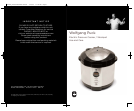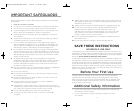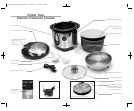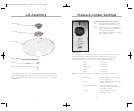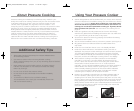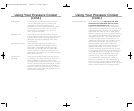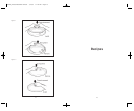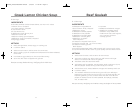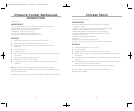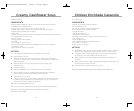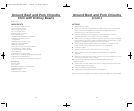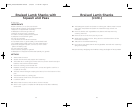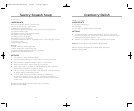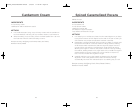
14
Helpful Hints (cont.)
• Remember if you are not using the basket while pressure cooking the
liquid will flavor what you are cooking. Try using fresh herbs or
aromatic vegetables like onions or garlic, wine or stock. The flavor
transference will be wonderful.
• Do not attempt to boil pasta with pressure lid on; the foam can
clog the pressure valve.
• When cooking under pressure, never fill above teh fill line of PC
markings. If you are making soup and you are at the fill line, do not
release pressure manually because hot liquid could spurt out.
• Never attempt to open lid while under pressure!!! Always open
pressure cooker with the lid facing away from you.
• When releasing steam manually, evaporation of some liquid may
occur (i.e. when making rice or risotto). This is normal, but caution
must be used to prevent injury.
Care & Cleaning
1 Allow pressure cooker to cool completely before cleaning. Unplug
the power cord from the outlet and then from the pressure cooker.
2 Wash the pressure cooker removable pot, sealing gasket and lids by
hand with warm, soapy water. Dry all parts thoroughly. (See Figure 1
for removing and installing sealing gasket).
3 If necessary, wipe the power cord clean with a damp cloth. Dry
thoroughly. Never immerse the power cord or plug.
4 Replace sealing gasket securely in lid. After each use, check gasket
for any tears and make sure the pressure regulator dial and valve are
in good working order. Also remove the anti-blockage cover, steam
release dial, and clean the steam vent thoroughly (See Figure 2).
Ensure that there are no food particles or any other foreign matter
are blocking the steam vents prior to putting the anti-blockage
cover and steam release dial back on the lid. The anti-blockage cover
helps prevent food particles from entering Steam Release Valve.
You must ensure that this is cleaned after each use. It is important
to check the steam vent thoroughly and use a narrow utensil, if
necessary, to poke through the steam vent and ensure that it is clear
and that no food particles adhere to the walls, thus blocking the
steam from being able to be freely released.
5 Do not store pressure cooker with lid locked in place. If you store the
lid locked onto the pressure cooker it will reduce the life of the
gasket since it will stay compressed during non-use.
13
Helpful Hints
• Read this manual thoroughly and follow all recommendations.
• Be familiar with the recipe and have all ingredients ready before you begin.
• Be sure the lid is secured properly before beginning.
• You may wish to brown some meats before cooking with
other ingredients. To do so, select any cooking function and preheat
pressure cooker without lid. Add oil and brown meat. Do not cover
when browning.
• Cut foods into uniform-size pieces to promote even cooking. In recipes
that call for various ingredients, cut those that cook more quickly into
larger pieces and those that cook more slowly into smaller pieces.
• Many different cooking liquids can be used in a pressure cooker:
wine, beer, bouillon, fruit juices, water and more.
• After becoming familiar with your pressure cooker, you can
convert conventional recipes for pressure cooking. In general,
reduce cooking times by two thirds. The amount of liquid used may
also have to be adjusted because there is very little evaporation from
the pressure cooker. Reduce the amount of liquid so there is only
about 1/2 cup more than desired in the finished product. Remember,
however, there must always be some liquid in the pressure cooker to
form the necessary steam. Try this formula ; 1 cup of liquid for the
first 15 minutes of pressure cooking then 1/3 cup of liquid for each
subsequent 15 minutes.
• Since flavors are more concentrated, reduce amounts of herbs and
seasonings when converting conventional recipes. Fresh herbs are
better for pressure cooking than dried herbs.
• Generally speaking, pressure cookers cook foods in about 1/3 the
time of conventional cooking methods.
• Increase cooking times by about ten percent when cooking in high
altitudes over 3,500 feet.
• If you wish to cook food for less time than the pre-programmed
amount, watch the timer and press CANCEL when desired cooking
time has elapsed.
• When you are using frozen meats in your recipes, the cooking time
does not need to be altered. Pressure will not be achieved until the
internal temperature in the pot is 40 degrees higher than the boiling
point of water. The cooking time will not begin until pressure is
achieved; it will just take longer to come to pressure.
• Always check to make sure your gasket and float valve are clean and
in good working order.
TSCDIST_PressureCooker manual 7/20/07 11:29 AM Page 13



